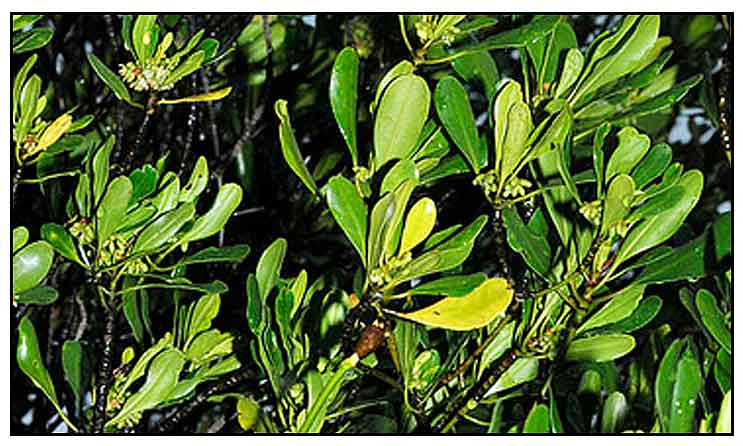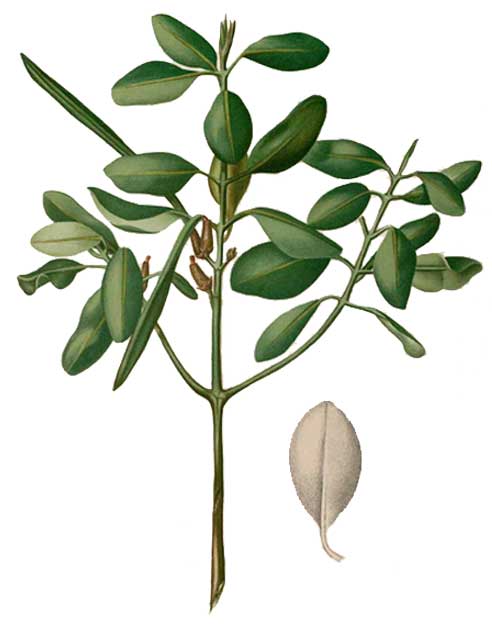 Botany Botany
Tañgal is a small tree growing up to 8 meters or less in height, with many buttresses at the base. Bark is dark red. Leaves are ovate, 5 to 7.5 centimeters long, 2 to 5 centimeters wide, blunt at the tip and pointed at the base. Flowers are about 6 millimeters in length, borne on short stalks. Calyx lobes are linear, with pointed tips. Petals are five, smooth; tips are flat or notched, with three of four club-shaped appendages. Stamens are ten. Fruit is small, club-shaped or subovoid, surrounded near the base by the reflexed segments of
the calyx.
 Distribution Distribution
- Abundant in mangrove swamps throughout the Philippines.
- Also occurs in India to Malaya.
- Listed as "vulnerable" on the Red List of threatened plants of Singapore.
(19)
Constituents
- Aerial parts yielded three new lupane-type triterpenes, 3a-O-trans-feruloylbetulinic acid, 3a-O-trans-coumaroylbetulinic acid and 3ß-O-cis-feruloylbetulin, with 10 known triterpenes.
- Phytochemical screening of stems and leaves yielded
flavonoids, anthraglycosides, bitter principle, saponins, terpenoids, and essential oils. (See study below) (12)
- Total phenolic content of wood and bark extracts in gallic acid equivalent (GAE) were
141.86 mg GAE/100 g sample and 181.91 mg GAE/100 mg g sample, respectively. (see study below) (14)
- Water soluble amino
acids constituents of Ceriops tagal fruit were lysine, threonine, valine, phenylalanine, tryptophan, and proline, while hypocotyl yielded arginine, glutamic acid, tryptophan, and alanine. (see study below) (15)
- Study of hypocotyls and fruits of Ceriops tagal yielded three new dammarane triterpenes, cereotagaloperoxide (1), cereotagalo A (2), and cereotagalol B (3), together with four known dammarane triterpenes, an oleanane triterpene, and 13 known lupane triterpenes. (18)
- Study of stems and twigs yielded seven dolabrane-type diterpenes, namely tagalsins A-G, along with the norditerpene tagalsin H. (23)
- Study of the edible mangrove fruit yielded a high total protein content, ash content (4.3%), and a fiber content of 15.64%. (26)
Properties
- Whole plant is considered astringent.
- Stem-bark considered vulnerary and anti-infective.
- Bark is astringent, hemostatic, and used as quinine substitute.
- Studies have suggested antitumor, antihyperglycemic, antibacterial, antioxidant properties.
Parts used
Bark.
Uses
Edibility
- Fruit reportedly eaten by natives of the Andamans (19)
Folkloric
- Decoction of the bark used to stop hemorrhages; applied to malignant ulcers.
- Bark used for diabetes.
- In the African Coast, decoction of shoots used as substitute for quinine.
- Malay women use a decoction of bark in childbirth.
- In India, bark used as hemostatic.
- In Malaysia, bark lotion used for ulcers and abdominal ailments.
- In India, chewing of stem bark is used to cure injury infection. Juice from stem bark used to stop hemorrhage and to cure eczema (25)
Others
- Dye: In eastern Africa and Asia, stem bark used for dyeing and tanning. In SE Asia, source of "soga browns" of Javanese batiks.
- Preservative: In fishing communities, bark extract used to preserve nets and sails from decay.
- Wood: Poles, planks and wattlework for house building.
Studies
• Dolabrane Diterpene / Tagalsin / Cytotoxicity:
Study isolated a new dolabrane-type diterpene, tagalsin, together with six known analogues. Cytotoxicity of the isolated compounds was evaluated against HeLa human cervical carcinoma cancer cell line. (2)
• Anti-Tumor / Triterpenes:
Study of 95% ethanol extract from embryo of Ceriops tagal yielded four triterpenes and tested against three cell lines. Compounds 1 and 3 were effective in inhibiting cell proliferation and growth of H-7402 and HeLa. (4)
• Antihyperglycemic:
Study evaluated the antihyperglycemic effect of the crude extract of Ceriops tagal showed significant improvement of glucose tolerance in sucrose-loaded normal rats and a 10.9% reduction of hyperglycemia in STZ-induced diabetic rats. (5)
• Antihyperglycemic / Hexose Uptake Stimulation:
Study on the effect of an ethanolic extract and its fractions on H-2-deoxyglucose uptake by cultured L6 rat muscle cells showed enhancement of glucose uptake comparable with insulin and metformin. Results suggest the n-hexane soluble fraction might be a potential source of new antihyperglycemic compounds. (7)
• Antibacterial / Leaves and Bark:
Study evaluated the antibacterial activity of the leaves and bark extracts of Ceriops tagal and Pemphis acidula against human pathogens such as P. aeruginosa, K. pneumonia, V parahemolyticus, S aureus and V cholera. P acidula showed higher antibacterial potency than C tagal. In all the tests, the crude methanolic extracts showed better inhibition. (6)
• Antitumor:
Dolabrane diterpenes of Ceriops tagal exhibited significant antitumor effect in the LLC mice probably through induced apoptosis of tumor cell and the lower expression of the tumor-associated transcription factor NF-KPp65. (8)
• Dolaborane Diterpenes / Tagalsins / Roots / Anticancer:
Study investigated the anticancer activity of tagalsins A-G isolated from the roots of C. tagal. Tagalsins A- G induced apoptosis through activation of caspase-3 enzyme. Tagalsin A was the most active. Results suggest a potential for the development of anticancer agents with novel mechanisms of actions. (9)
• Antioxidant / Stems and Leaves:
Study evaluated the antioxidant activity and phytochemicals in stems and leaves of C. tagal. Study confirmed the free radical scavenging potential of C. tagal. The leaves showed higher dose-dependent reducing power. Phytoscreening yielded flavonoids, anthraglycosides, bitter principle, saponins, terpenoids, and essential oils. (12)
• Total Phenolic Content / Fungitoxic Property / Bark:
Study evaluated bark and wood water soluble extracts of mangrove "tangal" as a potential antifungal agent against wood pathogenic fungi Lasiodyplodia theobromae. The bark extract was more effective in controlling fungal growth when compared with the wood extract. Results suggest some of the phenolics in tangal could inhibit fungal growth and development. (see constituents above) (14)
• Potential for Supplementing Animal Feed: Study analyzed organic and inorganic constituents of fruit and hypocotyl of Ceriops tagal. Both showed high concentration of carbohydrates and crude fibers, with very low amounts of fat and protein. It was rich in Na, K, and Ca, and was fairly high in calorific values. Results showed a potential source for supplementing animal feed. (see constituents above) (15)
• Bioactive Terpenoids / Antidiabetic / Leaves:Study of air dried leaves showed promising antidiabetic activity (PTPase inhibitory activity). Bioassay guided fractionation yielded 12 chemical molecules. Four molecules stearic acid (94.2%), betulin (94.4%), ß-hydroxy betulinic acid (90.5%) and ursolic acid (91.6%) showed promising PTPase activity at 100 µg/ml. (16)
• Proanthocyanidines / Antioxidant / Leaves: Study evaluated the relationships between degree of polymerization and antioxidant activities of subfractions obtained by fractionation of proanthocyanidins from Ceriops tagal leaves. (17)
• Cytotoxicity / Anticancer / Fruit: Study evaluated the anticancer activity of methanol extract of fruit of C. tagal against MDA-MB-231 (breast cancer) and HCT-116 (colon cancer) cell lines. Results showed anticancer activity with IC50 values of 50.57 µg/ml and 38.51 µg/ml for MDA-MB-231 and HCT-116 cell lines, respectively. (20)
• Antibacterial / Phenolic Content / Bark: Study evaluated various extracts of dried leaves and bark for phenolic content and antibacterial activity. The methanolic bark extract showed higher total phenolic content of 6.063 ± 0.205 mg GAE/g extract. Antimicrobial activity was tested against B. cereus, E. coli, S. aureus, and S. typhi using paper disk diffusion method. The methanol extracts of bark showed best activity. None of the extracts showed activity against E. coli. (21)
• Antifouling Metabolites / Roots: Study of roots yielded a new diterpene methoxy-ent-8(14)-pimarenely-15-one (1) and three known metabolites: ent-8(14)-pimarene-15R,16-diol (2), stigmasterol (3) and β-sitosterol (4). Compounds 1, 2, 3, and 4 exhibited significant antifouling activities against cyprid larvae of the barnacle Balanus albicostatus Pilsbry, with EC50 of 0.32, 0.04, 4.05 and 18.47 µg/cm2, respectively, with low toxicities towards cyprids (LC50 values all above 10 µg/cm2. (22)
•
Cytotoxic Effect / WiDr Colon Cancer Cell Lines / Polyisoprenoids / Leaves: Study evaluated the cytotoxic effects of polyisoprenoids from R. mucronata and Ceriops taga leaves. The polyisoprenoids of RM and CT leaves exhibited toxicity against WiDr cell line, with IC50s of 278 ± 5.77 and 276 ± 0.54 µg/ml, respectively. The polyisoprenoids significantly induced apoptosis and caused cell cycle arrest in G0/G1 pases, and decreased expression of Bcl2- and cyclin D1. Results showed the polyisoprenoids have potential to be developed as anti-colon cancer agents. (24)
Availability
Wild-crafted. |

![]()



 Botany
Botany Distribution
Distribution